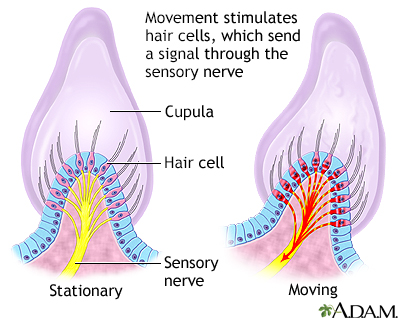
Vertigo - positional - aftercare; Benign paroxysmal positional vertigo - aftercare; BPPV - aftercare; Dizziness - positional vertigo

You may have seen your health care provider because you have had benign positional vertigo. It is also called benign paroxysmal positional vertigo, or BPPV. BPPV is the most common cause of vertigo and the easiest to treat.
Your provider may have treated your vertigo with the Epley maneuver. These are head movements that very often correct the inner ear problem that causes BPPV. After you go home:
Most of the time, treatment will cure BPPV. Sometimes, vertigo may return after a few weeks. About half the time, BPPV will come back later on. If this happens, you will need to be treated again. Your provider may prescribe medicines that can help relieve spinning sensations. But, these medicines often do not work well for treating the actual vertigo.
If vertigo returns, remember that you can easily lose your balance, fall, and hurt yourself. To help keep symptoms from getting worse and to help keep you safe:
To keep your symptoms from getting worse, avoid the positions that trigger it. Your provider may show you how to treat yourself at home for BPPV. A physical therapist may be able to teach you other exercises to reduce your symptoms.
You should contact your provider if:
Baloh RW, Jen JC. Hearing and equilibrium. In: Goldman L, Cooney KA, eds. Goldman-Cecil Medicine. 27th ed. Philadelphia, PA: Elsevier; 2024:chap 396.
Bhattacharyya N, Gubbels SP, Schwartz SR, et al. Clinical practice guideline: benign paroxysmal positional vertigo (update) executive summary. Otolaryngol Head Neck Surg. 2017;156(3):403-416. PMID: 28248602 pubmed.ncbi.nlm.nih.gov/28248602/.
Crane BT, Minor LB. Peripheral vestibular disorders. In: Flint PW, Francis HW, Haughey BH, et al, eds. Cummings Otolaryngology: Head and Neck Surgery. 7th ed. Philadelphia, PA: Elsevier; 2021:chap 167.
BACK TO TOPReview Date: 4/18/2024
Reviewed By: Linda J. Vorvick, MD, Clinical Professor, Department of Family Medicine, UW Medicine, School of Medicine, University of Washington, Seattle, WA. Also reviewed by David C. Dugdale, MD, Medical Director, Brenda Conaway, Editorial Director, and the A.D.A.M. Editorial team.

|
A.D.A.M., Inc. is accredited by URAC, also known as the American Accreditation HealthCare Commission (www.urac.org). URAC's accreditation program is an independent audit to verify that A.D.A.M. follows rigorous standards of quality and accountability. A.D.A.M. is among the first to achieve this important distinction for online health information and services. Learn more about A.D.A.M.'s editorial policy, editorial process and privacy policy. A.D.A.M. is also a founding member of Hi-Ethics and subscribes to the principles of the Health on the Net Foundation (www.hon.ch). |
The information provided herein should not be used during any medical emergency or for the diagnosis or treatment of any medical condition. A licensed medical professional should be consulted for diagnosis and treatment of any and all medical conditions. Call 911 for all medical emergencies. Links to other sites are provided for information only -- they do not constitute endorsements of those other sites. © 1997- A.D.A.M., Inc. Any duplication or distribution of the information contained herein is strictly prohibited.